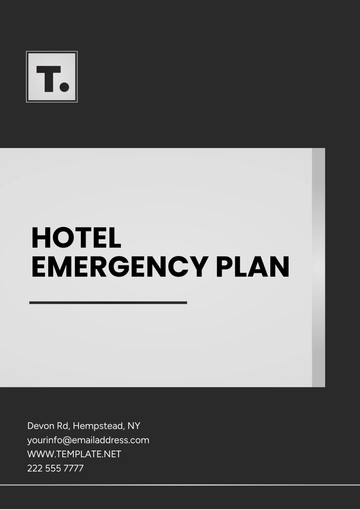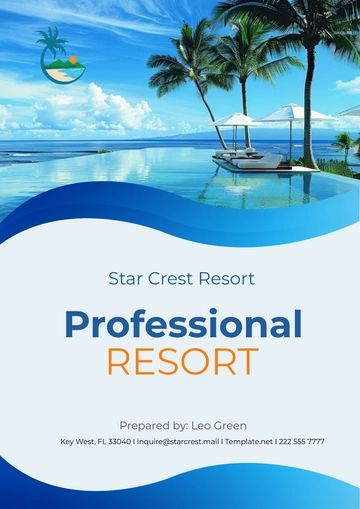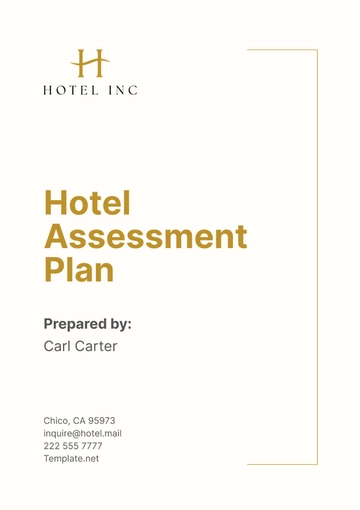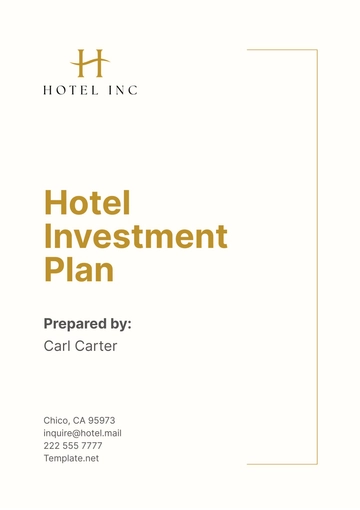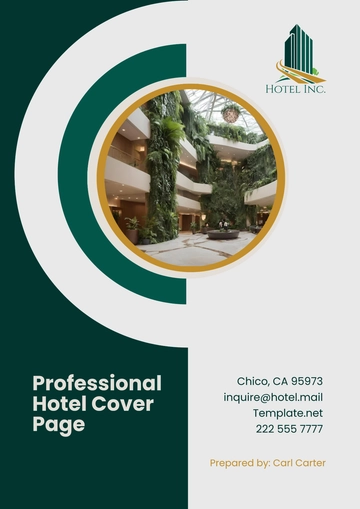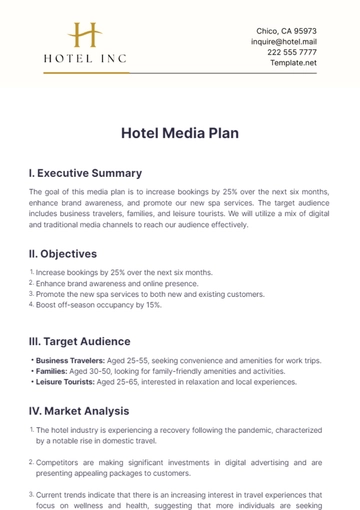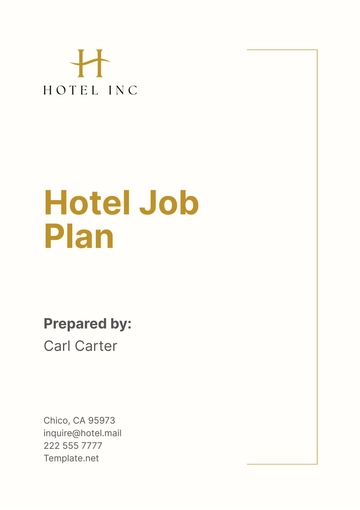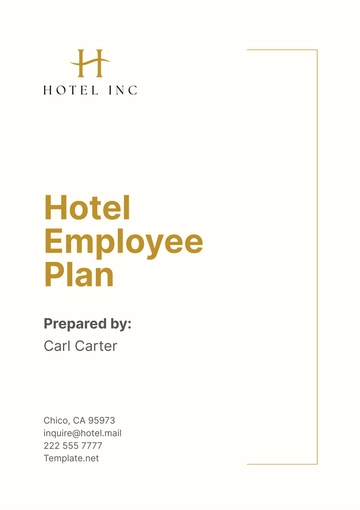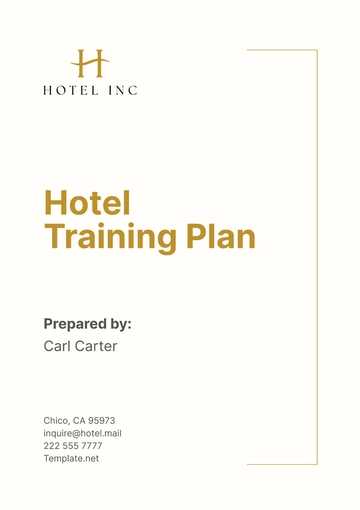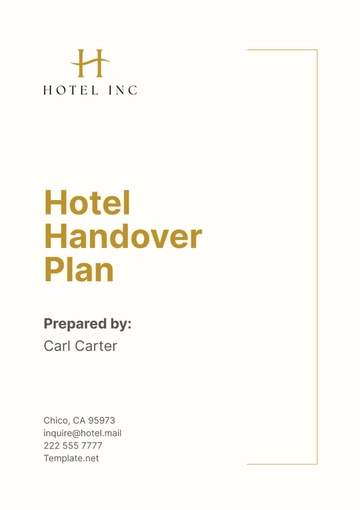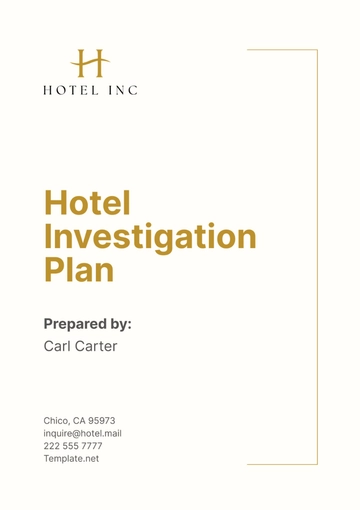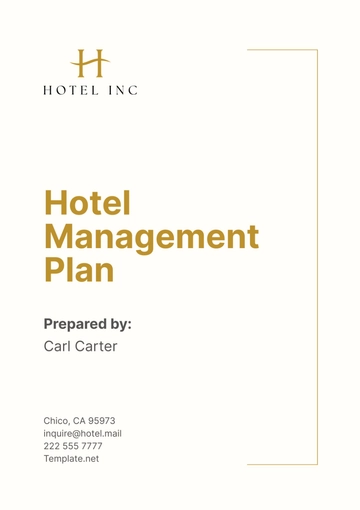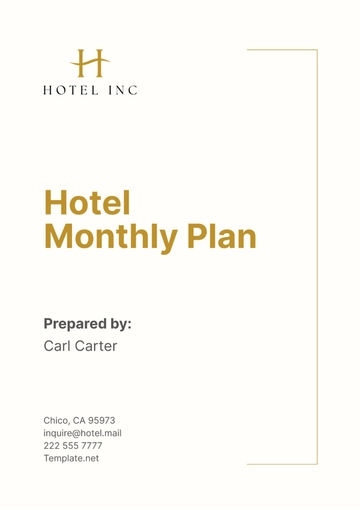Free Hotel Management Plan
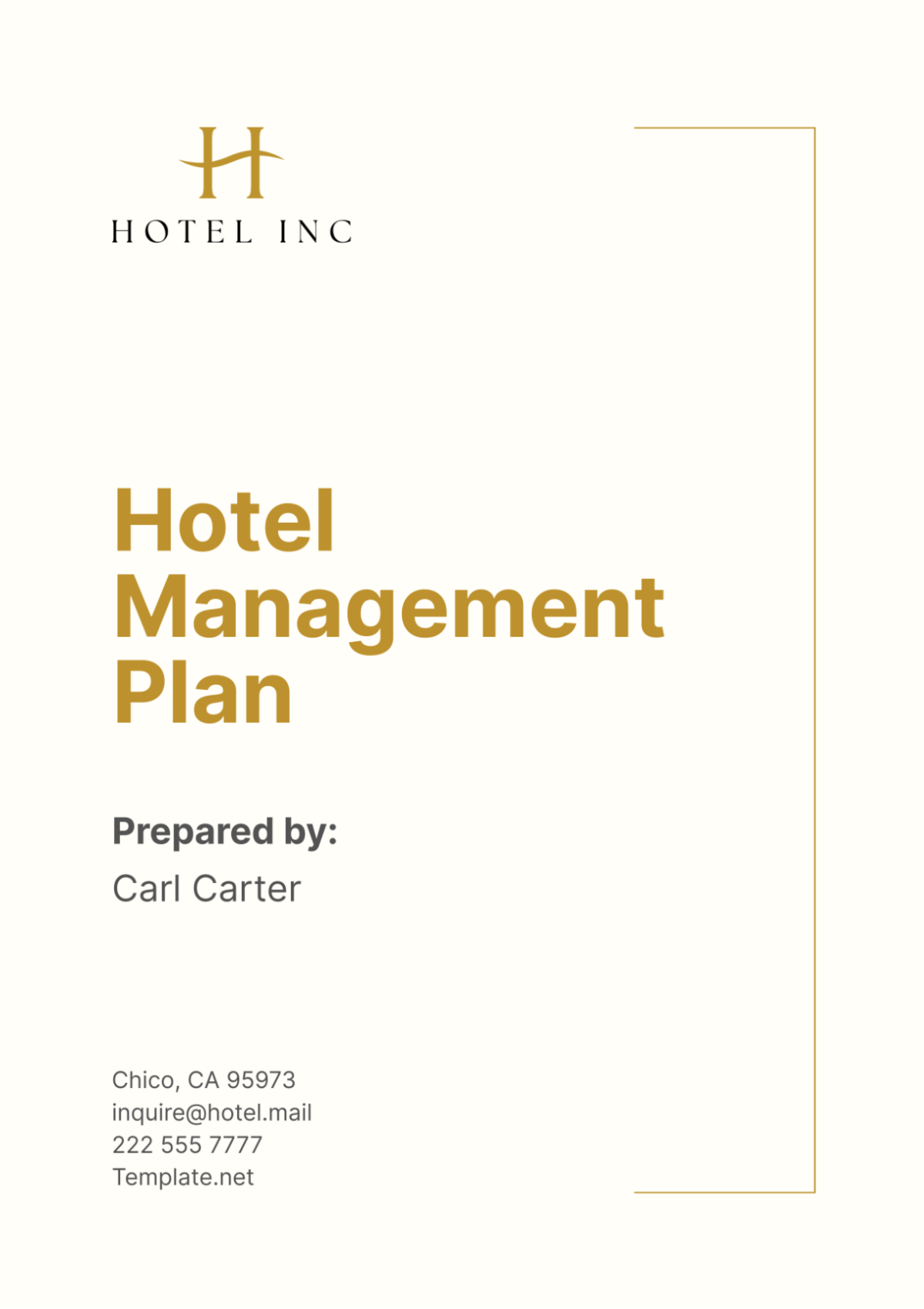
I. Executive Summary
A. Overview of the Hotel
[Your Company Name] is a premier hotel located in the heart of [City], renowned for its exceptional hospitality and luxurious accommodations. Established in [Year], the hotel has consistently offered guests an unforgettable experience marked by comfort, elegance, and outstanding service. With a total of [Number] rooms, including deluxe suites, family rooms, and executive suites, [Your Company Name] caters to a diverse clientele, ranging from business travelers to vacationing families.
B. Mission and Vision Statements
Mission Statement:
At [Your Company Name], our mission is to provide unparalleled hospitality by creating a welcoming and memorable environment for our guests. We strive to exceed expectations through exceptional service, luxurious accommodations, and a commitment to sustainability.
Vision Statement:
Our vision is to be the leading hotel in [City], recognized for our dedication to guest satisfaction, innovative services, and sustainable practices. We aim to set the standard for excellence in the hospitality industry.
C. Summary of Key Objectives
Achieve a 90% guest satisfaction rate within the next year.
Increase occupancy rates by 15% over the next two years.
Implement sustainable practices to reduce our carbon footprint by 25% in the next five years.
Enhance staff training programs to improve service quality and efficiency.
Expand marketing efforts to attract international tourists and business travelers.
II. Market Analysis
A. Industry Overview
The global hotel industry has experienced steady growth over the past decade, driven by increasing international travel and tourism. The industry is characterized by fierce competition, with hotels constantly seeking innovative ways to attract and retain guests. Key trends include the rise of boutique hotels, the growing importance of sustainable practices, and the increasing use of technology to enhance guest experiences.
B. Target Market Analysis
[Your Company Name] primarily targets the following market segments:
Business Travelers: Professionals visiting [City] for corporate events, conferences, and meetings.
Leisure Travelers: Tourists seeking a luxurious and comfortable stay while exploring local attractions.
Families: Families looking for spacious accommodations and family-friendly amenities.
International Tourists: Visitors from abroad attracted by [City]'s cultural and historical landmarks.
Market Segment | Key Characteristics | Marketing Strategies |
|---|---|---|
Business Travelers | High spending, short stays, require amenities like Wi-Fi and meeting rooms | Corporate partnerships, business travel packages |
Leisure Travelers | Longer stays, interested in local experiences and leisure activities | Tourism promotions, packages including local tours |
Families | Need spacious rooms, family-friendly services | Family packages, special activities for children |
International Tourists | Diverse backgrounds, seek cultural experiences | Multilingual services, partnerships with travel agencies |
C. Competitor Analysis
[Your Company Name] faces competition from several well-established hotels in [City]. Key competitors include:
Hotel A: Known for its modern amenities and central location. Strengths include high-tech facilities and a strong online presence. Weaknesses include high room rates and limited family-friendly services.
Hotel B: Popular for its budget-friendly rates and excellent customer service. Strengths include affordability and a loyal customer base. Weaknesses include fewer luxury amenities and smaller room sizes.
Hotel C: Renowned for its historical charm and unique architecture. Strengths include a distinctive brand and attractive package deals. Weaknesses include outdated facilities and limited technological integration.
D. SWOT Analysis
Strengths | Weaknesses |
|---|---|
Prime location in the heart of [City] | Higher operational costs due to luxury offerings |
Luxurious accommodations and amenities | Dependence on tourism seasonality |
Strong brand reputation | Limited market presence outside [City] |
Excellent customer service | High staff turnover rates |
Opportunities | Threats |
|---|---|
Expansion into new markets | Economic downturns affecting travel |
Adoption of sustainable practices | Intense competition from established brands |
Partnerships with local businesses | Fluctuations in international tourism |
Leveraging technology for enhanced services | Changes in regulatory policies |
III. Hotel Operations Plan
A. Organizational Structure
The organizational structure at [Your Company Name] is designed to ensure efficient operations and high-quality service. The key departments include:
General Management: Oversees overall hotel operations and strategic planning.
Front Office: Manages guest services, reservations, and check-ins/outs.
Housekeeping: Ensures cleanliness and maintenance of guest rooms and public areas.
Food and Beverage: Operates restaurants, bars, and room service.
Sales and Marketing: Develops and implements marketing strategies to attract guests.
Human Resources: Manages recruitment, training, and employee relations.
Finance: Handles budgeting, accounting, and financial reporting.
Security: Ensures the safety and security of guests and staff.
B. Staff Roles and Responsibilities
Position | Responsibilities |
|---|---|
General Manager | Provides leadership, oversees operations, and develops strategic plans |
Front Office Manager | Manages guest services, handles complaints, and supervises front desk staff |
Housekeeping Manager | Oversees cleaning staff, and ensures cleanliness standards are met |
Executive Chef | Manages kitchen operations, menu planning, and food quality |
Sales Manager | Develops sales strategies, builds partnerships, and drives revenue |
HR Manager | Manages recruitment, training, and employee performance |
Financial Controller | Oversees financial operations, budgeting, and reporting |
Security Manager | Ensures the safety of guests and staff, manages security protocols |
C. Daily Operations Procedures
Front Office Operations:
Check-In/Check-Out: Efficient handling of guest arrivals and departures, ensuring minimal wait times.
Reservations: Managing online and offline bookings, maintaining accurate records.
Concierge Services: Assisting guests with local information, transportation, and special requests.
Housekeeping Operations:
Daily Cleaning: Thorough cleaning of guest rooms and public areas, adhering to hygiene standards.
Laundry Services: Providing laundry and dry-cleaning services for guests.
Maintenance: Regular inspection and maintenance of hotel facilities to ensure functionality and safety.
Food and Beverage Operations:
Restaurant Services: Providing high-quality dining experiences, including breakfast, lunch, and dinner.
Room Service: Offering in-room dining options with prompt delivery.
Event Catering: Managing food and beverage services for events and conferences.
Security Operations:
Surveillance: Monitoring security cameras and patrolling hotel premises.
Emergency Response: Implementing emergency procedures and coordinating with local authorities.
Guest Safety: Ensuring the safety of guests through regular drills and safety checks.
D. Guest Services and Amenities
[Your Company Name] offers a wide range of services and amenities to enhance the guest experience:
Complimentary Wi-Fi: High-speed internet access throughout the hotel.
Fitness Center: A fully equipped gym available to all guests.
Spa and Wellness: A variety of spa treatments and wellness programs.
Swimming Pool: Indoor and outdoor pools for relaxation and recreation.
Business Center: Facilities for business travelers, including meeting rooms and office services.
Concierge Services: Personalized assistance with travel arrangements, dining reservations, and local attractions.
Airport Shuttle: Complimentary transportation to and from the airport.
E. Housekeeping and Maintenance Procedures
Housekeeping:
Daily Room Cleaning: Standard cleaning procedures including dusting, vacuuming, and sanitizing bathrooms.
Turn-Down Service: Evening service that includes refreshing the room, replacing towels, and preparing the bed.
Deep Cleaning: Scheduled deep cleaning of rooms and public areas to maintain high hygiene standards.
Maintenance:
Routine Inspections: Regular checks of all hotel facilities to identify and address any issues.
Preventive Maintenance: Scheduled maintenance of equipment and systems to prevent breakdowns.
Emergency Repairs: 24/7 availability of maintenance staff to handle urgent repairs.
F. Safety and Security Protocols
Emergency Procedures:
Evacuation Plan: Clearly marked evacuation routes and regular drills for guests and staff.
Fire Safety: Smoke detectors, fire alarms, and extinguishers strategically placed throughout the hotel.
Medical Emergencies: First aid kits and trained staff are available to respond to medical emergencies.
Guest Security:
Surveillance Cameras: Comprehensive CCTV coverage in all public areas.
Access Control: Secure key card access to guest rooms and restricted areas.
Security Personnel: Trained security staff patrolling the premises round-the-clock.
IV. Marketing and Sales Strategy
A. Marketing Objectives
Increase brand awareness in key target markets.
Drive direct bookings through the hotel’s website.
Boost occupancy rates during off-peak seasons.
Enhance the hotel’s online reputation through positive reviews and social media engagement.
Develop partnerships with local businesses and travel agencies to attract more guests.
B. Branding and Positioning
[Your Company Name] positions itself as a luxury hotel offering unparalleled comfort and personalized service. Our brand emphasizes elegance, sophistication, and a commitment to excellence. Key branding elements include:
Logo and Visual Identity: A distinctive logo and cohesive visual elements that reflect the hotel’s luxury status.
Tagline: “Experience Unmatched Elegance and Comfort.”
Brand Voice: Warm, welcoming, and professional tone in all communications.
C. Marketing Channels
Digital Marketing:
Website: A user-friendly, mobile-optimized website with an integrated booking engine.
Search Engine Optimization (SEO): Enhancing online visibility through targeted keywords and high-quality content.
Pay-Per-Click (PPC) Advertising: Online ads targeting specific demographics and locations.
Social Media: Active presence on platforms like Facebook, Instagram, and LinkedIn to engage with guests and share updates.
Print Marketing:
Brochures and Flyers: Distributing high-quality print materials at travel fairs, local attractions, and partner businesses.
Magazines and Newspapers: Advertising in popular travel and lifestyle publications to reach a broader audience.
Partnerships:
Local Businesses: Collaborating with nearby attractions, restaurants, and shops to offer exclusive deals to our guests.
Travel Agencies: Partnering with travel agencies to promote our hotel to international tourists.
D. Sales Strategies and Promotions
Seasonal Packages: Offering special rates and packages during holidays and peak seasons.
Corporate Rates: Providing discounted rates for business travelers and corporate clients.
Loyalty Programs: Rewarding repeat guests with points, discounts, and exclusive benefits.
Special Events: Hosting events such as wine tastings, cooking classes, and cultural nights to attract guests and enhance their stay.
E. Customer Relationship Management
[Your Company Name] uses a robust Customer Relationship Management (CRM) system to track guest preferences, manage bookings, and personalize communications. Key CRM strategies include:
Guest Profiles: Maintaining detailed profiles to offer personalized services and recommendations.
Feedback and Reviews: Collecting guest feedback through surveys and online reviews to identify areas for improvement.
Targeted Marketing: Sending personalized emails and offers based on guest preferences and past stays.
F. Social Media and Online Presence
Content Strategy:
Visual Content: Sharing high-quality photos and videos of the hotel, amenities, and local attractions.
Engaging Posts: Creating content that engages followers, such as travel tips, guest stories, and behind-the-scenes glimpses.
Influencer Collaborations: Partnering with travel influencers to reach a wider audience and build credibility.
Online Reviews:
Encouraging Reviews: Requesting guests to leave reviews on platforms like TripAdvisor, Google, and Yelp.
Responding to Feedback: Addressing both positive and negative reviews promptly and professionally to show our commitment to guest satisfaction.
V. Financial Plan
A. Revenue Projections
Projected revenue for [Your Company Name] over the next five years is based on expected occupancy rates, average room rates, and additional revenue streams such as food and beverage sales, event hosting, and ancillary services.
Year | Occupancy Rate | Average Room Rate | Total Revenue |
|---|---|---|---|
Year 1 | 75% | $200 | $3,650,000 |
Year 2 | 80% | $210 | $3,920,000 |
Year 3 | 85% | $220 | $4,250,000 |
Year 4 | 87% | $230 | $4,570,000 |
Year 5 | 90% | $240 | $4,860,000 |
B. Profit and Loss Statement
A projected profit and loss statement for the first year of operations:
Category | Amount ($) |
|---|---|
Revenue | |
Room Sales | 2,730,000 |
Food and Beverage | 600,000 |
Events and Other Services | 320,000 |
Total Revenue | 3,650,000 |
Expenses | |
Staff Salaries | 1,200,000 |
Utilities and Maintenance | 500,000 |
Marketing and Advertising | 250,000 |
Food and Beverage Costs | 300,000 |
Other Operating Expenses | 200,000 |
Total Expenses | 2,450,000 |
Net Profit | 1,200,000 |
C. Cash Flow Analysis
Ensuring positive cash flow is critical for maintaining hotel operations and funding future growth. Key cash flow strategies include:
Timely Billing: Ensuring prompt billing and collection of payments from guests and clients.
Expense Management: Monitoring and controlling operational expenses to avoid overspending.
Contingency Fund: Maintaining a contingency fund to cover unexpected expenses and emergencies.
D. Break-Even Analysis
The break-even point is calculated by determining the level of occupancy and room rates required to cover all operational expenses.
Category | Amount ($) |
|---|---|
Fixed Costs | 1,800,000 |
Variable Costs per Room Night | 100 |
Average Room Rate | 200 |
Break-Even Occupancy | 60% |
This analysis shows that [Your Company Name] needs to achieve a 60% occupancy rate at an average room rate of $200 to cover all fixed and variable costs, ensuring profitability.
VI. Human Resources Plan
A. Recruitment and Hiring Process
[Your Company Name] is committed to hiring skilled and dedicated professionals to ensure the highest level of service for our guests. Our recruitment process includes:
Job Posting: Advertising open positions on our website, job boards, and through recruitment agencies.
Application Review: Screening resumes to identify qualified candidates.
Interviews: Conducting initial phone interviews followed by in-person interviews with department heads.
Background Checks: Performing thorough background checks to verify employment history, qualifications, and references.
Offer and Onboarding: Extending job offers and providing comprehensive onboarding to new employees, including orientation and training sessions.
B. Employee Training and Development
We believe that continuous training and development are crucial for maintaining high service standards. Our training programs include:
Orientation: Introducing new hires to the hotel’s culture, policies, and procedures.
Customer Service Training: Ensuring all staff members are skilled in providing exceptional guest experiences.
Technical Training: Offering role-specific training, such as front desk operations, housekeeping protocols, and food service techniques.
Leadership Development: Providing training programs for potential leaders to develop management and supervisory skills.
C. Performance Evaluation and Management
Performance evaluations are conducted regularly to ensure employees meet performance standards and identify areas for improvement. Our process includes:
Annual Reviews: Comprehensive evaluations based on performance metrics, guest feedback, and peer reviews.
Feedback Mechanism: Regular feedback sessions to discuss performance, set goals, and identify development opportunities.
Incentives and Rewards: Implementing a rewards system to recognize outstanding performance, including bonuses, promotions, and employee of the month awards.
D. Employee Compensation and Benefits
We offer competitive compensation packages to attract and retain top talent. Our benefits include:
Salary: Competitive base salaries with potential for raises based on performance.
Health Insurance: Comprehensive health, dental, and vision insurance plans.
Paid Time Off: Generous vacation, sick leave, and paid holidays.
VII. Customer Service Plan
A. Guest Experience Goals
Our primary goal is to provide an exceptional guest experience that exceeds expectations. Key objectives include:
Personalized Service: Offering tailored services to meet individual guest preferences.
Consistency: Ensuring a consistent level of service across all departments and interactions.
Excellence: Striving for excellence in every aspect of the guest experience, from check-in to check-out.
B. Customer Service Policies
We have established clear customer service policies to guide our staff in delivering outstanding service. These policies include:
Courtesy and Respect: Treating all guests with courtesy, respect, and professionalism.
Responsiveness: Promptly addressing guest requests, questions, and concerns.
Problem Resolution: Efficiently resolving any issues or complaints to ensure guest satisfaction.
C. Feedback and Complaint Handling
We value guest feedback as it helps us improve our services. Our process for handling feedback and complaints includes:
Feedback Channels: Providing multiple channels for guests to share their feedback, including comment cards, online surveys, and direct communication with staff.
Complaint Resolution: Addressing complaints immediately and ensuring a satisfactory resolution for the guest.
Continuous Improvement: Analyzing feedback to identify trends and areas for improvement.
D. Loyalty Programs and Incentives
To encourage repeat business and reward loyal guests, we offer a comprehensive loyalty program:
Points System: Guests earn points for each stay, which can be redeemed for free nights, upgrades, and other rewards.
Exclusive Offers: Special promotions and discounts for loyalty program members.
Personalized Rewards: Tailoring rewards to individual preferences and stay patterns.
VIII. Risk Management Plan
A. Risk Identification and Assessment
Effective risk management involves identifying and assessing potential risks to the hotel’s operations. Key risks include:
Operational Risks: Equipment failures, supply chain disruptions, and service interruptions.
Financial Risks: Economic downturns, fluctuations in occupancy rates, and cost overruns.
Security Risks: Theft, vandalism, and unauthorized access.
Safety Risks: Fire hazards, health and safety violations, and natural disasters.
B. Emergency Response Plan
Our emergency response plan ensures the safety of guests and staff during emergencies. Key components include:
Evacuation Procedures: Clearly defined evacuation routes and procedures.
Emergency Contacts: Contact information for emergency services and hotel management.
Training: Regular emergency drills and training sessions for staff.
IX. Sustainability and Environmental Plan
A. Sustainability Goals and Objectives
[Your Company Name] is committed to sustainability and reducing our environmental impact. Our goals include:
Energy Efficiency | Reduce energy consumption by 20% over the next five years. |
Water Conservation | Decrease water usage by 15% within three years. |
Waste Reduction | Achieve a 50% reduction in waste sent to landfills within five years. |
Sustainable Sourcing | Source 75% of our food and supplies from sustainable sources. |
B. Community Engagement and Corporate Social Responsibility
We are dedicated to engaging with our community and supporting social responsibility initiatives:
Local Partnerships | Collaborate with local organizations on environmental and social projects. |
Charitable Contributions | Donate a portion of profits to local charities and community programs. |
Employee Volunteering | Encourage staff to participate in community service activities. |
X. Technology Plan
A. Hotel Management Software
We use advanced hotel management software to streamline operations and enhance guest experiences. Key features include:
Reservation System | Integrated booking engine for managing online and offline reservations. |
Guest Management | Comprehensive guest profiles for personalized service. |
Housekeeping Module | Efficient scheduling and tracking of housekeeping tasks. |
Reporting and Analytics | Real-time data and reports to inform decision-making. |
B. Reservation and Booking Systems
Our reservation and booking systems ensure a seamless booking experience for guests:
Online Booking | User-friendly online booking platform with real-time availability. |
Channel Management | Integration with various online travel agencies (OTAs) to maximize reach. |
Mobile App | Offering a mobile app for convenient booking and access to hotel services. |
C. Guest-Facing Technology
We leverage technology to enhance the guest experience:
In-Room Technology | Smart TVs, high-speed Wi-Fi, and voice-activated assistants in guest rooms. |
Mobile Check-In | Allow guests to check-in and access their rooms using smartphones. |
Digital Concierge | Digital concierge services for personalized recommendations and assistance. |
D. IT Infrastructure and Support
Our IT infrastructure supports efficient operations and seamless service delivery:
Network Infrastructure | High-speed internet and secure networks throughout the hotel. |
Cloud Services | Utilize cloud-based services for data storage and management. |
Technical Support | Provide 24/7 technical support to address any IT issues. |
XI. Implementation Plan
A. Timeline and Milestones
The implementation of [Your Company Name]’s Hotel Management Plan will follow a detailed timeline with key milestones:
Phase 1 (Month 1-3) | Initial planning, recruitment, and training of staff. |
Phase 2 (Month 4-6) | Implementation of marketing strategies and technology systems. |
Phase 3 (Month 7-9) | Launch of customer service initiatives and sustainability programs. |
Phase 4 (Month 10-12) | Finalizing financial plans and achieving initial revenue targets. |
B. Monitoring and Evaluation
Regular monitoring and evaluation are essential to ensure the success of the implementation plan:
Performance Metrics: Tracking key performance indicators (KPIs) such as occupancy rates, guest satisfaction, and revenue.
Progress Reports: Monthly progress reports to evaluate the implementation of each phase.
Adjustments and Improvements: Making necessary adjustments based on performance data and feedback.
C. Contingency Plans
We have developed contingency plans to address potential challenges and ensure smooth implementation:
Risk Mitigation: Identifying potential risks and implementing mitigation strategies.
Backup Plans: Establishing backup plans for critical operations and services.
Crisis Management: Preparing for emergencies with a detailed crisis management plan.
- 100% Customizable, free editor
- Access 1 Million+ Templates, photo’s & graphics
- Download or share as a template
- Click and replace photos, graphics, text, backgrounds
- Resize, crop, AI write & more
- Access advanced editor
Streamline management with Template.net's Hotel Management Plan Template. This customizable and editable template, accessible through the Ai Editor Tool, helps you outline detailed management plans. Personalize it to include specific goals and management strategies. Ensure clear and effective management planning to drive success, enhance leadership, and improve overall hotel operations.
You may also like
- Finance Plan
- Construction Plan
- Sales Plan
- Development Plan
- Career Plan
- Budget Plan
- HR Plan
- Education Plan
- Transition Plan
- Work Plan
- Training Plan
- Communication Plan
- Operation Plan
- Health And Safety Plan
- Strategy Plan
- Professional Development Plan
- Advertising Plan
- Risk Management Plan
- Restaurant Plan
- School Plan
- Nursing Home Patient Care Plan
- Nursing Care Plan
- Plan Event
- Startup Plan
- Social Media Plan
- Staffing Plan
- Annual Plan
- Content Plan
- Payment Plan
- Implementation Plan
- Hotel Plan
- Workout Plan
- Accounting Plan
- Campaign Plan
- Essay Plan
- 30 60 90 Day Plan
- Research Plan
- Recruitment Plan
- 90 Day Plan
- Quarterly Plan
- Emergency Plan
- 5 Year Plan
- Gym Plan
- Personal Plan
- IT and Software Plan
- Treatment Plan
- Real Estate Plan
- Law Firm Plan
- Healthcare Plan
- Improvement Plan
- Media Plan
- 5 Year Business Plan
- Learning Plan
- Marketing Campaign Plan
- Travel Agency Plan
- Cleaning Services Plan
- Interior Design Plan
- Performance Plan
- PR Plan
- Birth Plan
- Life Plan
- SEO Plan
- Disaster Recovery Plan
- Continuity Plan
- Launch Plan
- Legal Plan
- Behavior Plan
- Performance Improvement Plan
- Salon Plan
- Security Plan
- Security Management Plan
- Employee Development Plan
- Quality Plan
- Service Improvement Plan
- Growth Plan
- Incident Response Plan
- Basketball Plan
- Emergency Action Plan
- Product Launch Plan
- Spa Plan
- Employee Training Plan
- Data Analysis Plan
- Employee Action Plan
- Territory Plan
- Audit Plan
- Classroom Plan
- Activity Plan
- Parenting Plan
- Care Plan
- Project Execution Plan
- Exercise Plan
- Internship Plan
- Software Development Plan
- Continuous Improvement Plan
- Leave Plan
- 90 Day Sales Plan
- Advertising Agency Plan
- Employee Transition Plan
- Smart Action Plan
- Workplace Safety Plan
- Behavior Change Plan
- Contingency Plan
- Continuity of Operations Plan
- Health Plan
- Quality Control Plan
- Self Plan
- Sports Development Plan
- Change Management Plan
- Ecommerce Plan
- Personal Financial Plan
- Process Improvement Plan
- 30-60-90 Day Sales Plan
- Crisis Management Plan
- Engagement Plan
- Execution Plan
- Pandemic Plan
- Quality Assurance Plan
- Service Continuity Plan
- Agile Project Plan
- Fundraising Plan
- Job Transition Plan
- Asset Maintenance Plan
- Maintenance Plan
- Software Test Plan
- Staff Training and Development Plan
- 3 Year Plan
- Brand Activation Plan
- Release Plan
- Resource Plan
- Risk Mitigation Plan
- Teacher Plan
- 30 60 90 Day Plan for New Manager
- Food Safety Plan
- Food Truck Plan
- Hiring Plan
- Quality Management Plan
- Wellness Plan
- Behavior Intervention Plan
- Bonus Plan
- Investment Plan
- Maternity Leave Plan
- Pandemic Response Plan
- Succession Planning
- Coaching Plan
- Configuration Management Plan
- Remote Work Plan
- Self Care Plan
- Teaching Plan
- 100-Day Plan
- HACCP Plan
- Student Plan
- Sustainability Plan
- 30 60 90 Day Plan for Interview
- Access Plan
- Site Specific Safety Plan
